The Antlia constellation contains one formally named star and its name, as approved by the International Astronomical Union (IAU), is Macondo (HD 93083). There are no stars brighter than magnitude 3.00 in Antlia and the brightest star is Alpha Antliae, which is a fourth magnitude star. The constellation also contains two stars located within 10 parsecs (32.6 light years) of Earth, with the nearest star being only 13.15 light years distant from Earth.
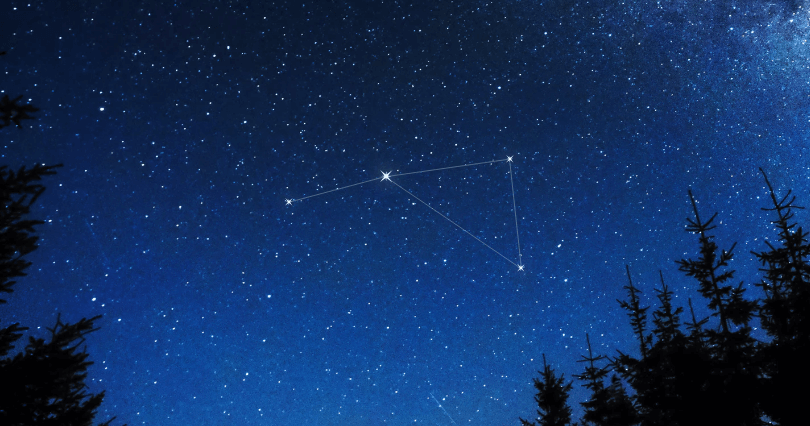
The constellation is home to two stars with known planets — HD 93083 and WASP-66. There are no Messier objects in the constellation and no meteor showers associated with it, but there are a number of interesting deep sky objects, such as the Antlia Cluster of Galaxies, the Antlia Dwarf Galaxy and the spiral galaxies NGC 3244 and IC 2560.
History and Mythology
Abbé Nicolas Louis de Lacaille first described Antlia constellation as la Machine Pneumatique (the Pneumatic Machine) in 1751–52, commemorating the air pump. The constellation was catalogued in Lacaille’s Coelum Australe Stelliferum, published in 1763. This catalogue contained almost 10,000 southern stars, 42 nebulous objects, and 14 new constellations, now known as the Lacaille family.
In 1763, Lacaille Latinised the constellation’s name to Antlia pneumatica and English astronomer John Herschel proposed shrinking the name to one word in 1844 and thus it became Antlia. It was adopted as one of the 88 modern constellations in 1922 by the International Astronomical Union. The stars that now comprise Antlia are in a zone of the sky associated with the asterism/old constellation Argo Navis, which was then split up into three constellations — Vela, Puppis and Carina.
Lacaille gave nine stars in Antlia Bayer designations, labelling them Alpha through to Theta, combining two stars next to each other as Zeta. Gould later added a tenth, Iota Antliae. Beta and Gamma Antliae (now HR 4339 and HD 90156) ended up in the neighbouring constellation Hydra once the constellation boundaries were delineated in 1930.
Although they were visible to the Ancient Greeks, Antlia’s stars were too faint to have been commonly recognised as a figurative object, or part of one.
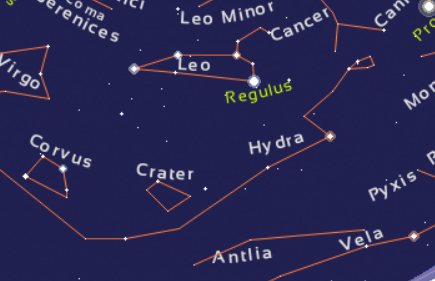
Location
The constellation of Antlia is one of the smallest constellations in the sky — it is 62nd in size and occupies an area of 239 square degrees. It is located in the second quadrant of the southern hemisphere (SQ2) and can be seen at latitudes between +45° and -90°.
Its right ascension is 09h 27m 05.1837s–11h 05m 55.0471s and its declination is −24.5425186°–−40.4246216°. It is best seen at 9pm, during the month of April. North of stars forming some of the sails of the ship Argo Navis (in the constellation Vela), Antlia is completely visible from latitudes south of 49 degrees north.
Antlia’s neighboring constellations are Centaurus, Hydra, Pyxis and Vela and it belongs to the Lacaille family of constellations, along with Caelum, Circinus, Fornax, Horologium, Mensa, Microscopium, Norma, Octans, Pictor, Reticulum, Sculptor and Telescopium.
Notable Stars
Alpha Antliae
Alpha Antliae is the brightest star in the constellation of Antlia and has an apparent magnitude that varies between 4.22 and 4.29. It is is an orange giant of spectral type K4III that is a suspected variable star. Shining with around 480 to 555 times the luminosity of the Sun, it is thought it will become a Mira-type variable before it turns into a white dwarf. It is around a billion years old and is located around 365 light years away.
Epsilon Antliae
Epsilon Antliae is the second brightest star in the constellation and has an apparent magnitude of 4.51. It is an evolved orange giant star of spectral type K3 IIIa that has a diameter about 69 times that of the Sun and a luminosity that is 1279 times that of the Sun. It is located around 700 light years away from us.
Delta Antliae
Delta Antliae is a binary star that is located around 481 light years away from us. The primary component is a blue-white main sequence star of spectral type B9.5V and magnitude 5.6, and the secondary is a yellow-white main sequence star of spectral type F9Ve and magnitude 9.6. They are separated by 11 arc seconds.
Zeta Antliae
Zeta Antliae is a wide optical double star. The primary component, Zeta-1 Antliae, has a magnitude of 5.74 and is located around 350 light years away from Earth, although it is thought to be a binary star system composed of two white main sequence stars of magnitudes 6.20 and 7.01 that are separated by 8.042 arcseconds. The companion is Zeta-2 Antliae, which has a magnitude of 5.9 and is located around 386 light years away from Earth.
Eta Antliae
Eta Antliae is a binary star that is located around 106 light years away from us. It is composed of a yellow white star of spectral type F1V and magnitude 5.31, with a companion of magnitude 11.3. They are separated by 31 arc seconds.
Theta Antliae
Theta Antliae, also known as IDS 09397-2719 B, is a binary star with an apparent magnitude of 4.78. It is located around 384 light years away from us. It is composed of a white A-type main sequence dwarf, Theta Antliae A, and a yellow-white F-type bright giant, Theta Antliae B.
Iota Antliae
Iota Antliae is an orange giant of spectral type K1 III with an apparent magnitude of 4.60. It is located around 199 light years away from us.
S Antliae
S Antliae is an eclipsing binary star system that varies in apparent magnitude from 6.27 to 6.83 over a period of 15.6 hours. The system is classed as a W Ursae Majoris variable, which means the primary is hotter than the secondary and the drop in magnitude is caused by the latter passing in front of the former. The primary star has a mass 1.94 times and a diameter 2.026 times that of the Sun, and the secondary has a mass 0.76 times and a diameter 1.322 times that of the Sun. The system is thought to be around 5 to 6 billion years old.
U Antliae
U Antliae is a red C-type carbon star with an apparent magnitude of 5.5. It is also an irregular variable star with a brightness that varies by 1.6 magnitudes. It is around 5819 times as luminous as the Sun and is located around 836 light years away from Earth.
AG Antliae
AG Antliae, also known as HD 89353, is a post-asymptotic giant branch star, which means it is an important source of dust enrichment. It is is an unusual hot variable ageing star of the spectral type B9.5Ib-II and is located around 6000 light years away from us. It has an apparent magnitude that ranges between 5.29 and 5.83 with a period of 429 days.
Deep Sky Objects
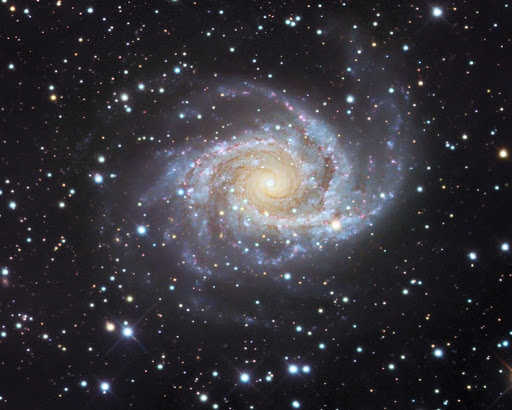
NGC 2997
NGC 2997, also known as ESO 434- G 35 or PGC 27978, is an unbarred spiral galaxy and the brightest galaxy in the NGC 2997 group, which are a group of galaxies, approximately 24.8 million light-years distant, belonging to the Local Supercluster. It has a magnitude of 10.6.
NGC 2997 is located around 24.8 million light years away from us and is a grand design galaxy, which means it has clearly defined spiral arms that extend around it. It is also notable because of the chain of hot giant clouds of ionized hydrogen surrounding the galaxy’s nucleus.
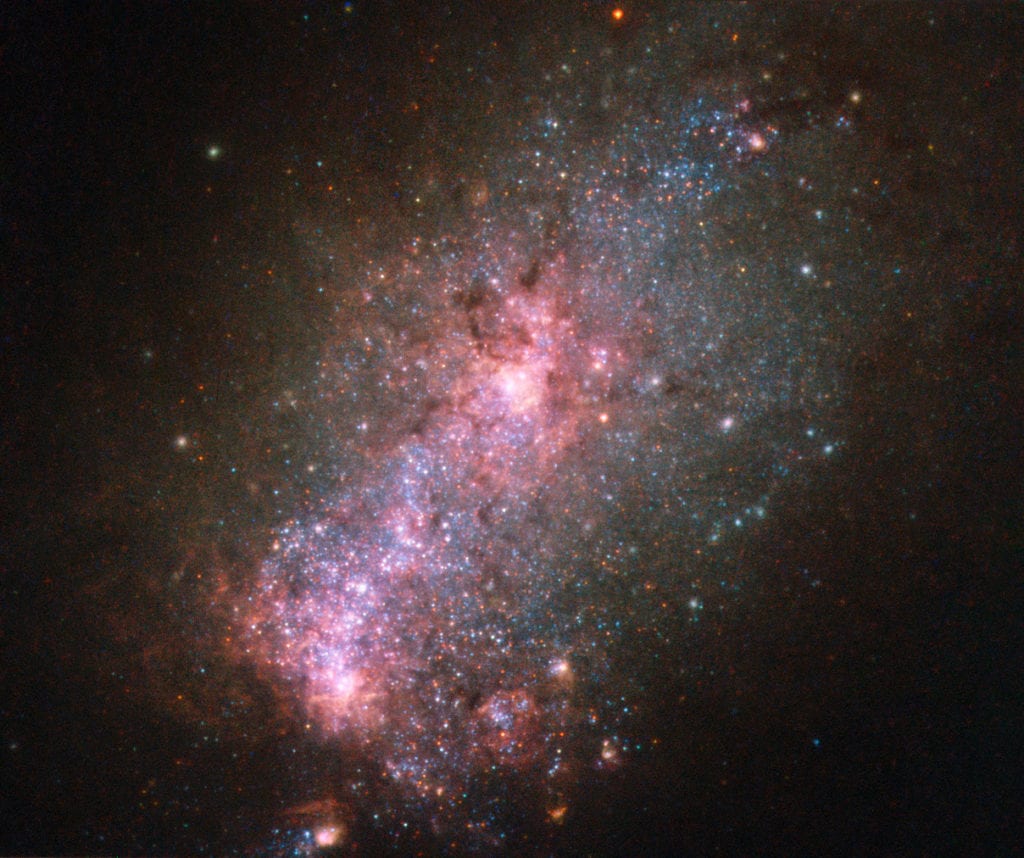
NGC 3125
NGC 3125 is a starburst galaxy with an apparent magnitude of 12.4 that was discovered by John Herschel on March 30, 1835. It is located around 50 million light years away from Earth and has has an apparent size of 1.5’ x 0.8’.
NGC 3244
NGC 3244 is a spiral galaxy with a visual magnitude of 12.89 that was discovered by John Herschel on April 22, 1835. It is located around 100 million light years away from us and has an apparent size of 2’ x 1.5’.
A supernova was discovered in NGC 3244 in June 2010. It reached a magnitude of about 14 and was designated SN 2010ev.
IC 2560
IC 2560 is a spiral galaxy in Antlia that has an apparent magnitude of 13.31 and occupies an area 2.79’ x 1.06’ in size. It is located around 110 million light years away from Earth.
IC 2545
IC 2545 is a pair of interacting galaxies that have a visual magnitude of 14.27 and were discovered by the American astronomer DeLisle Stewart on May 1, 1900. They are located around 450 million light years away from Earth and have an apparent size of 0.6’ x 0.4’.
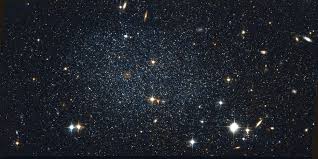
Antlia Dwarf Galaxy
The Antlia Dwarf Galaxy, also known as PGC 29194, is a dwarf spheroidal galaxy that is very faint, with an apparent magnitude of 16.2. It is located about 4.3 million light years away from Earth, lying on the outer rim of the Local Group of galaxies, and wasn’t discovered until 1997.
There is evidence suggesting that it is tidally interacting with another small galaxy, NGC 3109, that is located in the Hydra constellation.
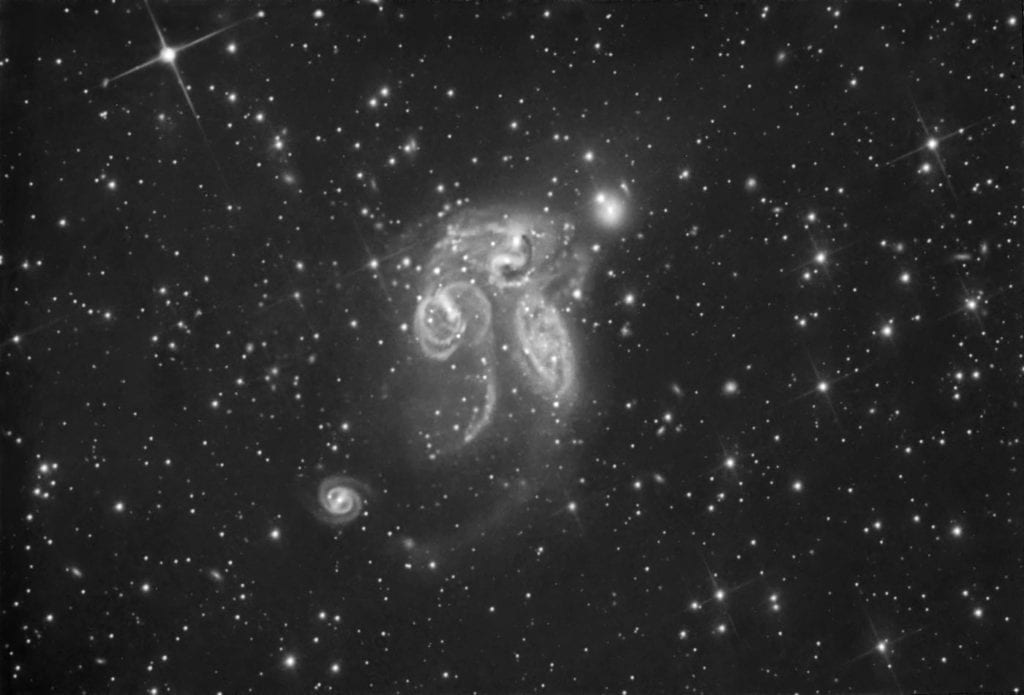
Antlia Cluster
The Antlia Cluster, also known as Abell S0636, is a cluster of galaxies within the Hydra–Centaurus Supercluster and the third closest cluster to our Local Group. It does not have a single brightest cluster galaxy and is therefore classified as a Bautz-Morgan type III cluster, which is a rather rare type of galaxy cluster.
The Antlia Cluster is located between 32.58 and 32.71 million light years away from Earth and contains about 234 galaxies. It is dominated by two massive elliptical galaxies, NGC 3258 and NGC 3268. Most of the galaxies in the Antlia Cluster are early type galaxies, with dwarf elliptical galaxies being the most common galaxy type.
Extra Facts
- The three-letter abbreviation for the constellation, as adopted by the International Astronomical Union, is “Ant”.
- The official constellation boundaries, as set by Belgian astronomer Eugène Delporte in 1930, are defined by a polygon with an east side, south side and ten other sides.
- Chinese astronomers were able to view what is modern Antlia from their latitudes, and incorporated its stars into two different constellations.
Images:
- Some Images created with the NightVision app – https://www.nvastro.com/nvj.html
- Some Images created with the Stelvision Sky Map https://www.stelvision.com/en/sky-map/
- Antlia 1 – https://starregistration.net/constellations/antlia-constellation.html
- NGC 2997 – http://annesastronomynews.com/photo-gallery-ii/galaxies-clusters/ngc-2997-by-robert-gendler/
- NGC 3125 – https://astronomynow.com/2016/07/18/hubble-reveals-a-galaxy-fit-to-burst/
- Antlia Dwarf Galaxy – https://en.wikipedia.org/wiki/Antlia_Dwarf
- Antlia Cluster – http://news.sky-map.org/imageView?image_id=256